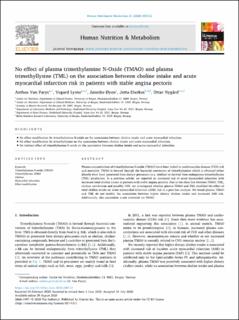No effect of plasma trimethylamine N-Oxide (TMAO) and plasma trimethyllysine (TML) on the association between choline intake and acute myocardial infarction risk in patients with stable angina pectoris
| dc.contributor.author | Van Parys, Anthea | |
| dc.contributor.author | Dierkes, Jutta | |
| dc.contributor.author | Lysne, Vegard | |
| dc.contributor.author | Øyen, Jannike | |
| dc.contributor.author | Nygård, Ottar Kjell | |
| dc.date.accessioned | 2022-01-18T08:55:19Z | |
| dc.date.available | 2022-01-18T08:55:19Z | |
| dc.date.created | 2022-01-14T15:08:45Z | |
| dc.date.issued | 2020 | |
| dc.identifier.issn | 2666-1497 | |
| dc.identifier.uri | https://hdl.handle.net/11250/2837805 | |
| dc.description.abstract | Plasma concentrations of trimethylamine N-oxide (TMAO) have been linked to cardiovascular disease (CVD) risk and mortality. TMAO is formed through the bacterial conversion of trimethylamine which is obtained either directly from food, generated from dietary precursors (e.g. choline) or derived from endogenous trimethyllysine (TML) production. In a previous article, we reported an increased risk of acute myocardial infarction with increased total choline intake in patients with stable angina pectoris. Due to the close link between TMAO, TML, choline metabolism and possibly CVD, we investigated whether plasma TMAO and TML modified the effect of total choline intake on acute myocardial infarction (AMI) risk in a post-hoc analysis. We found plasma TMAO and TML do not modify the association between higher dietary choline intake and increased AMI risk. Additionally, this association is not mediated via TMAO. | en_US |
| dc.language.iso | eng | en_US |
| dc.title | No effect of plasma trimethylamine N-Oxide (TMAO) and plasma trimethyllysine (TML) on the association between choline intake and acute myocardial infarction risk in patients with stable angina pectoris | en_US |
| dc.type | Others | en_US |
| dc.description.version | publishedVersion | en_US |
| dc.source.journal | Human Nutrition & Metabolism | en_US |
| dc.identifier.doi | 10.1016/j.hnm.2020.200112 | |
| dc.identifier.cristin | 1981405 | |
| cristin.ispublished | true | |
| cristin.fulltext | original |
Files in this item
This item appears in the following Collection(s)
-
Articles [3011]
-
Publikasjoner fra CRIStin [3061]
